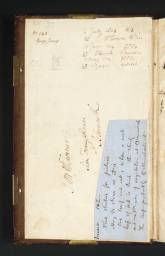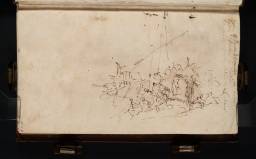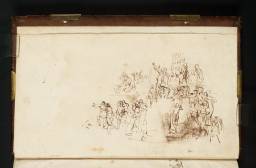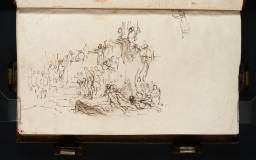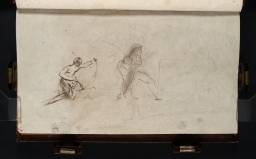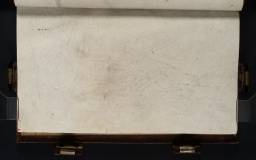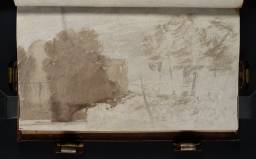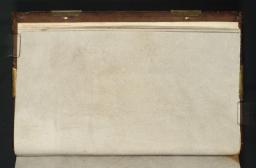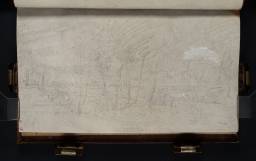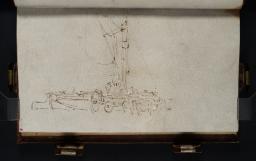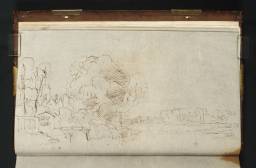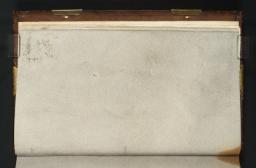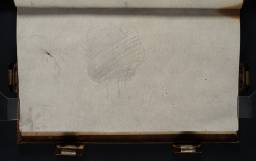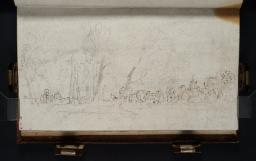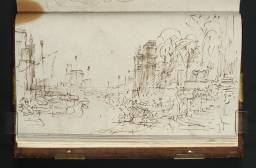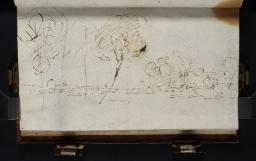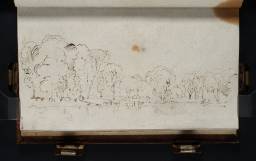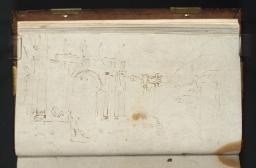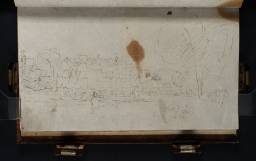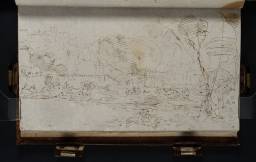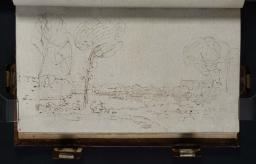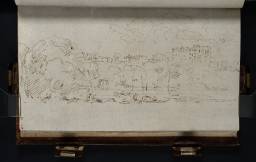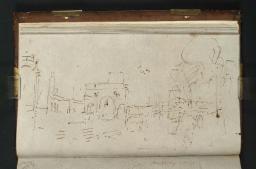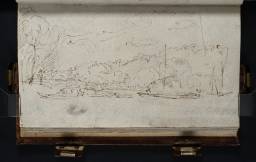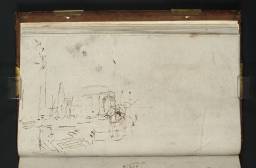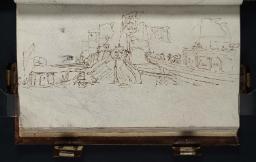Turner Bequest XC
Sketchbook, bound in calf, with gold tooling on spine and edges and four brass clasps
80 leaves of off-white wove paper made on a double-faced mould, prepared with a grey wash, and two flyleaves of white wove paper at front and back of the book
Approximate page size 150 x 258 mm
Main paper made by William Balston and the brothers Finch and Thomas Robert Hollingworth at Turkey Mill, Maidstone, Kent, and watermarked ‘1794 | J WHATMAN’. The flyleaves from an unknown maker, watermarked ‘1799’
Inscribed by Turner in ink ‘37 Studies for Pictures Isleworth’ on a label on the spine and ‘J M W Turner | Sion Ferry House | Isleworth’ inside front cover
Numbered in ink ‘142’ as part of the Turner Schedule and endorsed by the Executors of the Turner Bequest. Inscribed in ink by George Jones ‘No 142 | George Jones’ and by Charles Lock Eastlake and John Prescott Knight in pencil ‘C.L.E.’ and ‘JPK’ inside front cover. Also endorsed by John Ruskin ‘Invent 142. | Fine studies for pictures | May be shown as it is | One leaf torn out, where a real | leaf of herb is laid. The study | cut out was of vegetation at Warwick | The leaf probably to illustrate it’ on a piece of blue paper pasted inside front cover
80 leaves of off-white wove paper made on a double-faced mould, prepared with a grey wash, and two flyleaves of white wove paper at front and back of the book
Approximate page size 150 x 258 mm
Main paper made by William Balston and the brothers Finch and Thomas Robert Hollingworth at Turkey Mill, Maidstone, Kent, and watermarked ‘1794 | J WHATMAN’. The flyleaves from an unknown maker, watermarked ‘1799’
Inscribed by Turner in ink ‘37 Studies for Pictures Isleworth’ on a label on the spine and ‘J M W Turner | Sion Ferry House | Isleworth’ inside front cover
Numbered in ink ‘142’ as part of the Turner Schedule and endorsed by the Executors of the Turner Bequest. Inscribed in ink by George Jones ‘No 142 | George Jones’ and by Charles Lock Eastlake and John Prescott Knight in pencil ‘C.L.E.’ and ‘JPK’ inside front cover. Also endorsed by John Ruskin ‘Invent 142. | Fine studies for pictures | May be shown as it is | One leaf torn out, where a real | leaf of herb is laid. The study | cut out was of vegetation at Warwick | The leaf probably to illustrate it’ on a piece of blue paper pasted inside front cover
Exhibition history
References
This sketchbook belongs to the group used along the Thames, mainly from circa 1805. As well as sketches and studies of the riverside from nature, it contains many ideal, historical and classical compositions based on them and working with them in counterpoint. A number of important pictures, watercolours and prints originate in this book and this was reflected, together with its Isleworth origins, in the title Turner gave it when he came to name and label his sketchbooks in 1824. The book has fascinated scholars for its interplay of the real and ideal and for the brilliance and beauty of its coloured studies.
Turner’s Isleworth address, Sion (or Syon) Ferry House, written inside the front cover has proved critical to dating the book. In his Inventory Finberg dated it 1805–6 but later revised the range to 1811–12 in the belief that Turner moved from his Hammersmith residence to Sion Ferry House in 1811 and stayed there until his new house at Twickenham, Sandycombe Lodge, was ready.1 In fact, Turner vacated Sion Ferry House by October 1806. Finberg’s redating was maintained by John Gage2 and Gerald Wilkinson. However, it ignored Turner’s memorandum inside the front cover which includes dates as early as 5 May 1804, and Finberg was unaware that Turner was paying rates on Sion Ferry House by 17 January 1805.3 Gage described Turner’s letter from that address to Richard Colt Hoare of 23 November that year as ‘the earliest clearly dated reference to the address Turner used until 1811’4 although he also acknowledged the date of 1804 inside the sketchbook’s cover. Moreover the sketchbook contains a coloured study (folio 29 verso, D05532) for Windsor Castle from the Thames (Tate T03870; displayed at Petworth House),5 a picture which is inscribed ‘ISLEWORTH’ along with the signature indicating its execution there, is datable on stylistic grounds circa 1805 and might have been exhibited at Turner’s Gallery that year or the next. All these factors point to the sketchbook itself being the earliest evidence of Turner’s residence at Sion Ferry House and in use from 1804 through 1805, as pointed out by Butlin and Joll.6 However two drawings (36 verso and 37 verso, D05546, D05548) of subjects associated with a visit to Cassiobury Park in 1807 suggest occasional recourse to it later.
The sketches of Thames scenery include a good many in and around Isleworth, Sion Ferry House and Syon Park. Finberg thought there were numerous views of Windsor or Windsor Castle but more often they are of Richmond, Kew and other stretches of the river. A number were correctly identified by Edward Croft-Murray in marginal notes to a copy of Finberg now in Tate’s Library; more were recognised by David Hill whose 1993 book was the first significant revision of Finberg. Of particular interest are views of Kew Palace including not only the old ‘Dutch House’ but also the new castellated palace then under construction to James Wyatt’s designs but soon to be abandoned (for example folios 8 verso and 11, D05501, D05505); Turner even seems to have sketched barges delivering building materials (folio 8, D05500).
While much of Turner’s work at Isleworth shows strong naturalistic tendencies, his sketches in this book range from direct observations from nature to wholly idealised compositions in the classical style of Claude Lorrain. Thames views, observed with varying degrees of artistic licence, are juxtaposed with classical translations, the effect inviting comparison with musical variations on a theme. Sometimes these face each other across a single opening. At times Turner’s leaps of the imagination extend beyond landscape and scenery, as when a sketch of a state barge and shallop on the Thames (folio 20, D05518) prompts a vision of Cleopatra’s golden barge on the Cydnus (folio 84 verso, D05617). More often the transformations are of landscape, as when aspects of the riverside at Syon and Isleworth, and what is presumed to be the Pavilion designed by Robert Mylne in Syon Park are combined in compositions that eventually resolved themselves into Turner’s painting known as The Thames at Weybridge, 1807–10 (Tate T03872; displayed at Petworth House)7 but engraved as Isis for the Liber Studiorum. These include folio 33 (D05494), which also has studies of the figure of Apollo in Apollo and Python, exhibited in 1811 but possibly painted earlier (Tate N00488),8 and folios 4, 5, 6, 9, 29 and 31 (D05495, D05496, D05497, D05502, D05531, D05535). Other important landscape compositions originating in this sketchbook are Mercury and Herse exhibited in 1811 (on the London art market in 2005)9 and Dido and Aeneas exhibited in 1814 (Tate N00494).10 For the first of these see folio 17 (D05513) and the beautiful colour study on folio 21 (D05520); for the latter see especially folio 57 (D05581).
The book also has many examples of Turner transforming the Thames riverscape into ancient seaports, again in the style of Claude. Numerous sketches and studies show seaports or their buildings; for example folios 1 verso–2 (D05492–D05493), a similar design on folio 11 verso (D05506), folios 31 verso, 33 verso, 34, 34 verso, 38 verso and 49 verso–50 (D05536, D05540, D05541, D05542, D05550, D05568– D05569). Of these 11 verso and 31 verso are probably early ideas for Dido Building Carthage (National Gallery, London).11 The seaports often show Turner playing with ideas for dramatic arrivals or departures of heroes or tragic lovers: Jason and the Argonauts with the Golden Fleece; Ulysses returning Chryseis to her father Chryses; Cleopatra at Tarsus. On some leaves, for example folio 1 (D05491), Turner noted down alternative subjects, indicating that his drawings were often compositional templates at this early stage.
How Turner came by such a wide range of classical and historical themes may be wondered at, and a likely source is his boyhood friend (and future Executor) Henry Scott Trimmer, now rector of Heston about half a mile north-west of Sion Ferry House. A classical scholar, Trimmer gave Turner instruction in Greek and Latin in return for drawing lessons, and joined him on fishing trips along the river.12 Whatever their inspiration, Turner’s choice of themes was evidently far from random and shows the breadth of his reading of classical literature and history – Plutarch, Homer, Virgil, Ovid, Apollonius Rhodius (if still presumably in translation) – as well as a sensitive intelligence in choosing parallel subjects from different sources. In the case of folios 61 verso and 69 (D05588, D5597) he set out the rudiments of a sunlit bay that would serve as the background for his watercolour Chryses, 1811 (private collection),13 illustrating Homer’s Iliad, and the unpublished Liber Studiorum plate, Glaucus and Scylla, drawn from Ovid’s Metamorphoses. Although Claude’s Sea of Galilee with Christ Calling Peter and Andrew and Coast Scene with Perseus and the Origin of Coral, known to Turner from Richard Earlom’s 1777 engravings of Claude’s Liber Veritatis, were inspirations for the composition, it is generally true, as Kathleen Nicholson has pointed out, that Turner’s interpretations tend to reflect his reading of the texts as much if not more than existing pictorial sources. Likewise, in his designs for the Metamorphoses beginning on folio 54 (D05575), depicting Io, Mercury and Argus, Mercury and Herse, Pan and Syrinx or the sisters of Phaeton in suitable landscape settings, he draws on his current experience of Thames scenery to dream himself into Ovid’s enchanted world whose themes of transformation mirror those at work in the sketchbook itself.
In such exalted company, the two studies of a harvest home or supper on folios 36 verso and 37 verso (D05546, D05548) strike an incongruous note. They are also technically different from the other work in this book, being in black chalks instead of pencil, ink or watercolour. They are related to the drawings in the Harvest Home sketchbook (Tate D05351–D05375; D40273; D40342–D40343; Turner Bequest LXXXVI) and an oil of a harvest meal in a barn likely to have been intended for the Earl of Essex but left unfinished (Tate N00562).14 The painting mainly depicts an event on Essex’s Hertfordshire estate, Cassiobury Park, which Turner visited in 1807.15 It seems more likely that the two studies in this book were later additions, developed from or contemporary with his work at Cassiobury, than that they suggest an earlier and different location for the subject. Perhaps Turner took the book with him to Cassiobury to show his patron some of the other drawings in it, and especially the coloured studies in hope of a commission. There appear to be further related studies in another of his Isleworth sketchbooks, Hesperides (1) (Tate D05803, D05805, D05807; Turner Bequest XCIII 23a, 24a, 25a).
As discovered by Hill 1993, pp.24, 173 note 6. For information on rates payable in May 1805, see Patrick Youngblood, ‘The Painter as Architect: Turner and Sandycombe Lodge’, Turner Studies, vol.2, no.1, Summer 1982, p.34 note 9.
Technical notes
How to cite
David Blayney Brown, ‘Studies for Pictures: Isleworth sketchbook c.1804–7’, sketchbook, December 2009, in David Blayney Brown (ed.), J.M.W. Turner: Sketchbooks, Drawings and Watercolours, Tate Research Publication, December 2012, https://www

